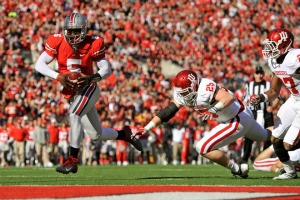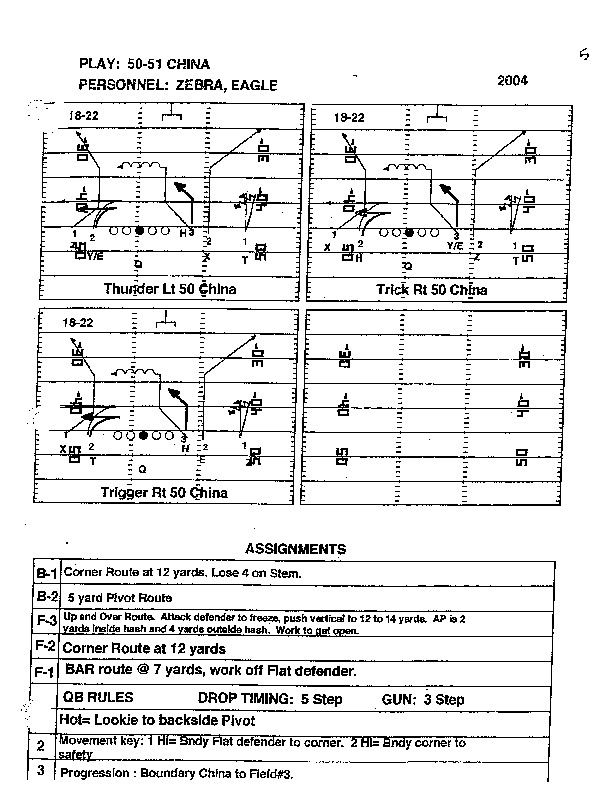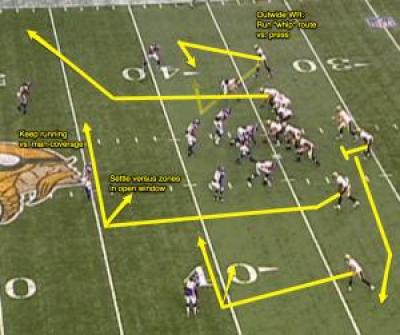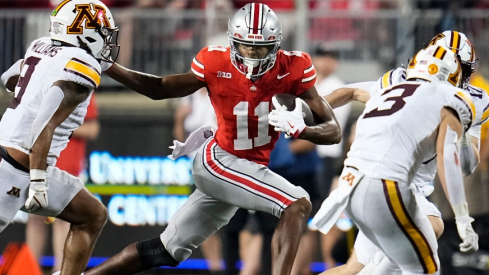 Using Concepts
Using ConceptsSimilar to the run offense, OSU's drop back pass game unmistakably bears Urban Meyer's stamp. From concepts to terminology, Meyer's system retains the same core plays that he learned from Joe Tiller and Scott Lineham. Yet Ohio State's coaching staff is also showing some subtle adaptations that should assist the OSU passing game in updating Meyer's system.
But first the similarities. Meyer's offense features many of the same staples he has utilized at his previous stops, such as four verticals, 'drive' (perhaps the most frequently run play during the spring game--see :21 second mark in the first video; 1:16 in the second); its cousin "follow" (1:05 mark) and 'Houston,' right down to the terminology.
For instance, here (at the :57 mark) is a good example of follow-pivot, another Meyer staple.
As further proof, one play OSU repeatedly repped was "RT 50 China." China is a vertical stretch (meaning it stresses the defense by putting two routes parallel to each other on a vertical plane), hi-lo concept similar to Smash. The difference is, rather than No. 1 running the hitch and 2 the corner route, the roles are reversed. No. 1 now runs a post-corner, while No. 2 runs a follow-pivot route that Meyer is fond-of. This provides the offense a different look to achieve the same hi-lo stretch.

In addition, with the TE running an up and over route and sitting down, the offense also achieves a 'triangle stretch.'
Ohio State also used an extensive amount of sprint-out passing, another Meyer trademark, particularly in short yardage and goal line situations.
Combining Concepts
While Meyer's offense thus exhibits many of the same staples, Meyer and Herman have also adapted the passing game to better address defensive coverages and give the QB increased options.
The reason is as follows. As Chris Brown discusses, most pass plays are designed to attack one, perhaps two coverages. In the past, a particular defense often would predominantly play one coverage type, allowing an offensive staff to know that the offense could upon their cover 2 or cover 3 plays for that day. Now, however, a defense is more likely to mix and match coverages. An offensive play caller must either guess right with his pass play call, then, or create ways that a pass play can succeed against any coverage. Meyer & Co have focused on doing the latter. To illustrate, I will show three ways that the OSU offensive coaching staff has mixed concepts with 'smash,' the traditional hi-lo play against cover 2.
For instance, one emphasis is upon backside 'tags.' Meyer's offenses used to run smash as a mirrored pattern. But this eliminates one half of the field. Now, Herman will call "51 Smash F Select." The front side route will still be smash. But the backside receiver will run an option route.

The quarterback is now provided a progression. If the defense, for example, runs cover 3, thereby limiting smash's effectiveness, the QB can work back to the tagged route.
In a similar vein, Meyer's scheme is also combining concepts. One frequent example from the spring game is combining smash with follow. This accomplishes several purposes. One, it combines the concept of a zone beater (smash) with a man beater (follow-crossing route). It also combines two zone beaters, with smash working against cover 2, and follow giving you a vertical hi-lo against cover 3. Finally, combining the crossing route with an outside pass play ideally combats the problem Brown identifies with combining concepts, namely leaving the inside pass defenders unoccupied as UFOs. Perhaps for that reason, most OSU's combined concepts generally mix a crossing route (drive or follow) with a smash type concept (as with the tag it also diminishes the field the QB needs to read).
Finally, Meyer and Herman's offense combined together the three step quick game (double slants) with the five step drop back smash play. I will touch on this in more detail later, but sufficed to say that again, the idea is to give the QB options, whereby he can attack the double slant if faced with man coverage, but if that is not there reset to work the five step smash read. In summation, Meyer and Herman have taken the base concepts Meyer has employed and made them more versatile to adapt again unknown pre-snap coverages, giving the offense more opportunities to succeed rather than having to guess correctly.
Bonus: Power (and its discontents)
To pick up what I discussed last week, the spring game again gave an example of how Meyer emphasizes traditional downhill run plays, but constrains the defense by running them from a variety of different looks and building constraint plays off those base plays. The play in this instance is 'power.' Jim Tressel referred to this play as 'Dave,' and it is a staple of nearly every NFL and college offense.
Meyer bases his offense around power and the related 'counter trey,' but runs it from so many angles that it looks like different plays. For instance, at the :20 mark in the second video above, you will see OSU run power to the halfback side from a strong H-back look, for a quicker hitting, short yardage play. Then, at the 1:32 mark in the first video, you will see OSU in the essentially the same formation. This time, however, they fake power away from the halfback's side, then have the quarterback run a naked bootleg with a backside comeback route. The offense is therefore designed to be relatively straightforward for the offense, as the action for everyone but the backfield is the same, yet give the defense a myriad of looks to contend with. The hope is to maintain simplicity for the offense, while feigning complexity for the defense to adjust to.

